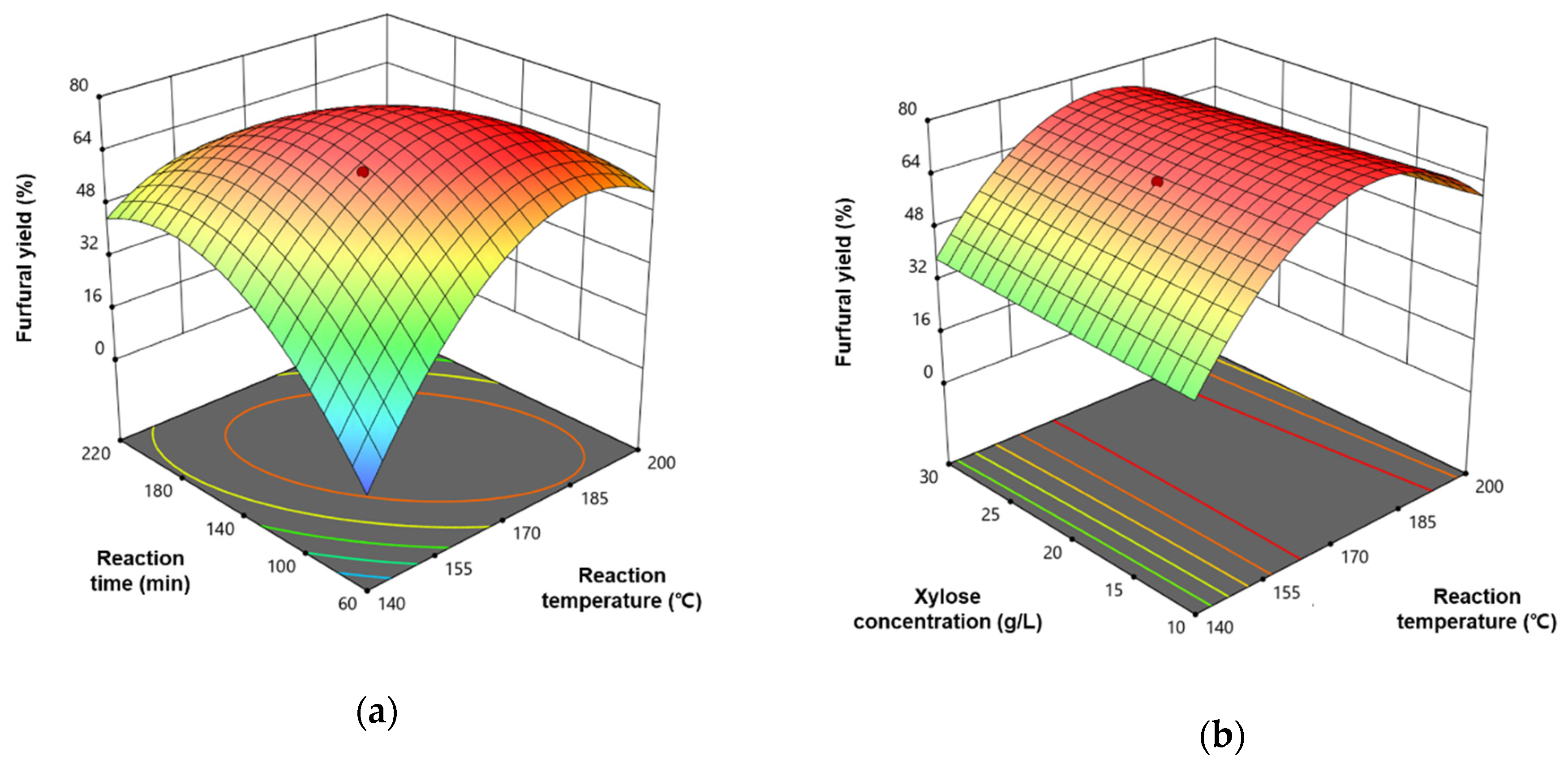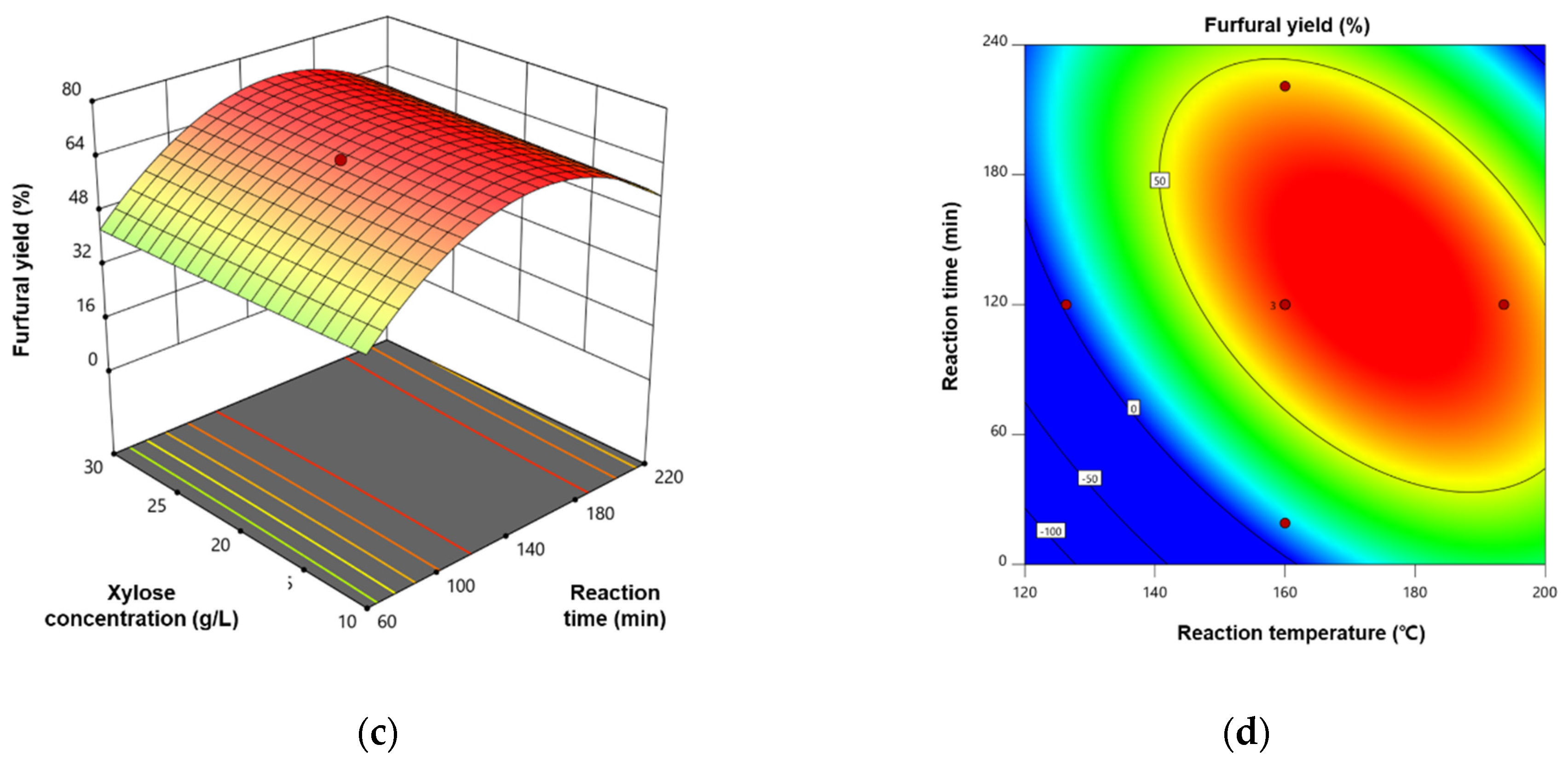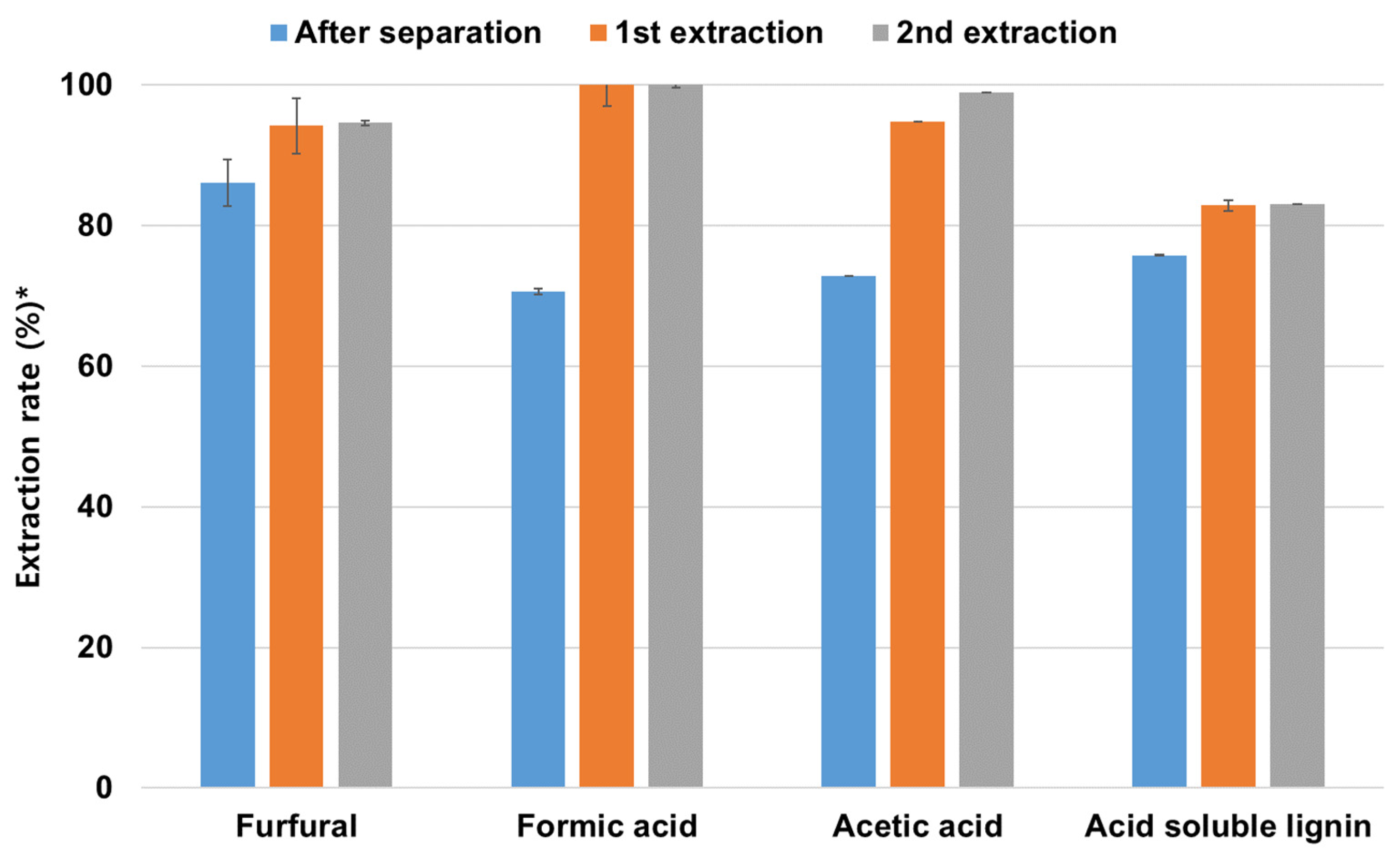A Simultaneous Conversion and Extraction of Furfural from Pentose in Dilute Acid Hydrolysate of Quercus mongolica Using an Aqueous Biphasic System
Abstract
1. Introduction
2. Materials and Methods
2.1. Materials
2.2. Dilute Acid Pretreatment for Pentose Production from Lignocellulosic Biomass
2.3. Response Surface Methodology for Optimization of Furfural Production from Xylose Standard
2.4. Furfural Production from Pentose Derived from Quercus Mongolica
2.5. Analysis of Furfural and Other Products in Mixed Hydrolysate
3. Results and Discussion
3.1. Pentose Production during Dilute Acid Pretreatment
3.2. RSM for Furfural Production from Xylose Standard Solution with Extracting Solvent
3.3. Effect of Organic Solvent for Furfural Production and Extraction
3.4. Production of Furfural from Pentose in Dilute Acid Hydrolysate
4. Conclusions
Author Contributions
Funding
Institutional Review Board Statement
Informed Consent Statement
Conflicts of Interest
References
- Stöcker, M. Biofuels and biomass-to-liquid fuels in the biorefinery: Catalytic conversion of lignocellulosic biomass using porous materials. Angew. Chem. Int. Ed. 2008, 47, 9200–9211. [Google Scholar] [CrossRef] [PubMed]
- Zhou, C.-H.; Xia, X.; Lin, C.-X.; Tong, D.-S.; Beltramini, J. Catalytic conversion of lignocellulosic biomass to fine chemicals and fuels. Chem. Soc. Rev. 2011, 40, 5588–5617. [Google Scholar] [CrossRef] [PubMed]
- Liu, Y.; Chen, W.; Xia, Q.; Guo, B.; Wang, Q.; Liu, S.; Liu, Y.; Li, J.; Yu, H. Efficient cleavage of lignin-carbohydrate complexes and ultrafast extraction of lignin oligomers from wood biomass by microwave-assisted treatment with deep eutectic solvent. ChemSusChem 2017, 10, 1692–1700. [Google Scholar] [CrossRef] [PubMed]
- Zhao, X.; Zhang, L.; Liu, D. Biomass recalcitrance. Part I: The chemical compositions and physical structures affecting the enzymatic hydrolysis of lignocellulose. Biofuels Bioprod. Biorefining 2012, 6, 465–482. [Google Scholar] [CrossRef]
- Mosier, N.; Wyman, C.; Dale, B.; Elander, R.; Lee, Y.; Holtzapple, M.; Ladisch, M.R. Features of promising technologies for pretreatment of lignocellulosic biomass. Bioresour. Technol. 2005, 96, 673–686. [Google Scholar] [CrossRef] [PubMed]
- Wyman, C.E.; Dale, B.E.; Elander, R.T.; Holtzapple, M.; Ladisch, M.R.; Lee, Y. Coordinated development of leading biomass pretreatment technologies. Bioresour. Technol. 2005, 96, 1959–1966. [Google Scholar] [CrossRef]
- Zhu, J.Y.; Pan, X.; Zalesny, R.S., Jr. Pretreatment of woody biomass for biofuel production: Energy efficiency, technologies, and recalcitrance. Appl. Microbiol. Biotechnol. 2010, 87, 847–857. [Google Scholar] [CrossRef]
- Puls, J. Chemistry and biochemistry of hemicelluloses: Relationship between hemicellulose structure and enzymes required for hydrolysis. Macromol. Symp. 1997, 120, 183–196. [Google Scholar] [CrossRef]
- Farhat, W.; Venditti, R.A.; Hubbe, M.; Taha, M.; Becquart, F.; Ayoub, A. A Review of water-resistant hemicellulose-based materials: Processing and applications. ChemSusChem 2017, 10, 305–323. [Google Scholar] [CrossRef]
- Mansilla, H.D.; Baeza, J.; Urzua, S.; Maturana, G.; Villaseñor, J.; Durán, N. Acid-catalysed hydrolysis of rice hull: Evaluation of furfural production. Bioresour. Technol. 1998, 66, 189–193. [Google Scholar] [CrossRef]
- Rivas, S.; Vila, C.; Santos, V.; Parajó, J.C. Furfural production from birch hemicelluloses by two-step processing: A potential technology for biorefineries. Holzforschung 2016, 70, 901–910. [Google Scholar] [CrossRef]
- Wang, X.; Zhang, C.; Lin, Q.; Cheng, B.; Kong, F.; Li, H.; Ren, J. Solid acid-induced hydrothermal treatment of bagasse for production of furfural and levulinic acid by a two-step process. Ind. Crop. Prod. 2018, 123, 118–127. [Google Scholar] [CrossRef]
- Weingarten, R.; Cho, J.; Conner, W.C., Jr.; Huber, G.W. Kinetics of furfural production by dehydration of xylose in a biphasic reactor with microwave heating. Green Chem. 2010, 12, 1423–1429. [Google Scholar] [CrossRef]
- Hu, X.; Westerhof, R.J.M.; Dong, D.; Wu, L.; Li, C.-Z. Acid-catalyzed conversion of xylose in 20 solvents: Insight into interactions of the solvents with xylose, furfural, and the acid catalyst. ACS Sustain. Chem. Eng. 2014, 2, 2562–2575. [Google Scholar] [CrossRef]
- Deng, A.; Lin, Q.; Yan, Y.; Li, H.; Ren, J.; Liu, C.; Sun, R. A feasible process for furfural production from the pre-hydrolysis liquor of corncob via biochar catalysts in a new biphasic system. Bioresour. Technol. 2016, 216, 754–760. [Google Scholar] [CrossRef]
- Chen, Z.; Bai, X.; Lusi, A.; Jacoby, W.A.; Wan, C. One-pot selective conversion of lignocellulosic biomass into furfural and co-products using aqueous choline chloride/methyl isobutyl ketone biphasic solvent system. Bioresour. Technol. 2019, 289, 121708. [Google Scholar] [CrossRef]
- Xu, S.; Pan, D.; Wu, Y.; Song, X.; Gao, L.; Li, W.; Das, L.; Xiao, G. Efficient production of furfural from xylose and wheat straw by bifunctional chromium phosphate catalyst in biphasic systems. Fuel Process. Technol. 2018, 175, 90–96. [Google Scholar] [CrossRef]
- Gürbüz, E.I.; Wettstein, S.G.; Dumesic, J.A. Conversion of hemicellulose to furfural and levulinic acid using biphasic reactors with alkylphenol solvents. ChemSusChem 2012, 5, 383–387. [Google Scholar] [CrossRef]
- Li, H.; Deng, A.; Ren, J.; Liu, C.; Wang, W.; Peng, F.; Sun, R.-C. A modified biphasic system for the dehydration of d-xylose into furfural using SO42−/TiO2-ZrO2/La3+ as a solid catalyst. Catal. Today 2014, 234, 251–256. [Google Scholar] [CrossRef]
- Sluiter, A.; Hames, B.; Ruiz, R.; Scarlata, C.; Sluiter, J.; Templeton, D.; Crocker, D. Determination of structural carbohydrates and lignin in biomass. Lab. Anal. Proced. 2008, 1617, 1–16. [Google Scholar]
- Jang, S.-K.; Kim, J.-H.; Choi, I.-G.; Choi, J.-H.; Lee, S.-M.; Choi, I.-G. Investigation of conditions for dilute acid pretreatment for improving xylose solubilization and glucose production by supercritical water hydrolysis from Quercus mongolica. Renew. Energy 2018, 117, 150–156. [Google Scholar] [CrossRef]
- Cabiac, A.; Guillon, E.; Chambon, F.; Pinel, C.; Rataboul, F.; Essayem, N. Cellulose reactivity and glycosidic bond cleavage in aqueous phase by catalytic and non catalytic transformations. Appl. Catal. A Gen. 2011, 402, 1–10. [Google Scholar] [CrossRef]
- Karimi, K.; Kheradmandinia, S.; Taherzadeh, M.J. Conversion of rice straw to sugars by dilute-acid hydrolysis. Biomass Bioenergy 2006, 30, 247–253. [Google Scholar] [CrossRef]
- Li, H.; Ren, J.; Zhong, L.; Sun, R.; Liang, L. Production of furfural from xylose, water-insoluble hemicelluloses and water-soluble fraction of corncob via a tin-loaded montmorillonite solid acid catalyst. Bioresour. Technol. 2015, 176, 242–248. [Google Scholar] [CrossRef] [PubMed]
- Thong, S.O.; Prasertsan, P.; Intrasungkha, N.; Dhamwichukorn, S.; Birkeland, N.-K. Optimization of simultaneous thermophilic fermentative hydrogen production and COD reduction from palm oil mill effluent by Thermoanaerobacterium-rich sludge. Int. J. Hydrogen Energy 2008, 33, 1221–1231. [Google Scholar] [CrossRef]
- Qing, Q.; Guo, Q.; Zhou, L.; Wan, Y.; Xu, Y.; Ji, H.; Gao, X.; Zhang, Y. Catalytic conversion of corncob and corncob pretreatment hydrolysate to furfural in a biphasic system with addition of sodium chloride. Bioresour. Technol. 2017, 226, 247–254. [Google Scholar] [CrossRef] [PubMed]
- Jang, S.-K.; Choi, I.-G.; Hong, C.-Y.; Kim, H.-Y.; Ryu, G.-H.; Yeo, H.; Choi, J.W.; Choi, I.-G. Changes of furfural and levulinic acid yield from small-diameter Quercus mongolica depending on dilute acid pretreatment conditions. J. Korean Wood Sci. Technol. 2015, 43, 838–850. [Google Scholar] [CrossRef][Green Version]
- López, F.; García, M.; Feria, M.; García, J.; De Diego, C.; Zamudio, M.; Diaz, M. Optimization of furfural production by acid hydrolysis of Eucalyptus globulus in two stages. Chem. Eng. J. 2014, 240, 195–201. [Google Scholar] [CrossRef]
- Zhang, T.; Kumar, R.; Wyman, C.E. Enhanced yields of furfural and other products by simultaneous solvent extraction during thermochemical treatment of cellulosic biomass. RSC Adv. 2013, 3, 9809–9819. [Google Scholar] [CrossRef]
- Shao, Y.; Hu, X.; Zhang, Z.; Sun, K.; Gao, G.; Wei, T.; Zhang, S.; Hu, S.; Xiang, J.; Wang, Y. Direct conversion of furfural to levulinic acid/ester in dimethoxymethane: Understanding the mechanism for polymerization. Green Energy Environ. 2019, 4, 400–413. [Google Scholar] [CrossRef]
- Zhu, Y.; Liab, W.; Lu, Y.; Zhang, T.; Jameel, H.; Chang, H.-M.; Ma, L. Production of furfural from xylose and corn stover catalyzed by a novel porous carbon solid acid in γ-valerolactone. RSC Adv. 2017, 7, 29916–29924. [Google Scholar] [CrossRef]
- Yang, W.; Liac, P.; Bo, D.; Chang, H. The optimization of formic acid hydrolysis of xylose in furfural production. Carbohydr. Res. 2012, 357, 53–61. [Google Scholar] [CrossRef] [PubMed]
- Gupta, N.K.; Fukuoka, A.; Nakajima, K. Amorphous Nb2O5 as a selective and reusable catalyst for furfural production from xylose in biphasic water and toluene. ACS Catal. 2017, 7, 2430–2436. [Google Scholar] [CrossRef]
- Whitaker, M.R.; Parulkar, A.; Brunelli, N.A. Selective production of 5-hydroxymethylfurfural from fructose in the presence of an acid-functionalized SBA-15 catalyst modified with a sulfoxide polymer. Mol. Syst. Des. Eng. 2020, 5, 257–268. [Google Scholar] [CrossRef]
- Zeitsch, K.J. The Chemistry and Technology of Furfural and Its Many By-Products, 1st ed.; Elsevier: Amsterdam, The Netherlands, 2000; Volume 13. [Google Scholar]
- Cheong, W.J.; Carr, P.W. Kamlet-Taft pi* polarizability/dipolarity of mixtures of water with various organic solvents. Anal. Chem. 1988, 60, 820–826. [Google Scholar] [CrossRef]
- Leggett, D.C. Modeling solvent extraction using the solvatochromic parameters .alpha., .beta., and .pi.*. Anal. Chem. 1993, 65, 2907–2909. [Google Scholar] [CrossRef]
- Crowhurst, L.; Falcone, R.; Lancaster, N.L.; Llopis-Mestre, V.; Welton, T. Using kamlet-taft solvent descriptors to explain the reactivity of anionic nucleophiles in ionic liquids. J. Org. Chem. 2006, 71, 8847–8853. [Google Scholar] [CrossRef]
- Zhang, T.; Liab, W.; Xu, Z.; Liu, Q.; Ma, Q.; Jameel, H.; Chang, H.-M.; Ma, L. Catalytic conversion of xylose and corn stalk into furfural over carbon solid acid catalyst in γ-valerolactone. Bioresour. Technol. 2016, 209, 108–114. [Google Scholar] [CrossRef]
- Liu, H.; Hu, H.; Jahan, M.S.; Ni, Y. Furfural formation from the pre-hydrolysis liquor of a hardwood kraft-based dissolving pulp production process. Bioresour. Technol. 2013, 131, 315–320. [Google Scholar] [CrossRef]
- Nguyen, T.Y.; Cai, C.M.; Kumar, R.; Wyman, C.E. Co-solvent pretreatment reduces costly enzyme requirements for high sugar and ethanol yields from lignocellulosic biomass. ChemSusChem 2015, 8, 1716–1725. [Google Scholar] [CrossRef]
- Wittmann, G.; Karg, E.; Mühl, A.; Bodamer, O.A.; Túri, S. Comparison of tetrahydrofuran and ethyl acetate as extraction solvents for urinary organic acid analysis. J. Inherit. Metab. Dis. 2008, 31, 73–80. [Google Scholar] [CrossRef] [PubMed]
- Xing, R.; Qi, W.; Huber, G.W. Production of furfural and carboxylic acids from waste aqueous hemicellulose solutions from the pulp and paper and cellulosic ethanol industries. Energy Environ. Sci. 2011, 4, 2193–2205. [Google Scholar] [CrossRef]
- Ahsan, L.; Jahan, S.; Khan, M.I.H.; Calhoun, L. Recovery of acetic acid from prehydrolysis liquor of kraft hardwood dissolving pulp using ion-exchange resin. Bioresources 2014, 9, 1588–1595. [Google Scholar] [CrossRef][Green Version]
- Uslu, H. Adsorption equilibria of formic acid by weakly basic adsorbent Amberlite IRA-67: Equilibrium, kinetics, thermodynamic. Chem. Eng. J. 2009, 155, 320–325. [Google Scholar] [CrossRef]
- Singh, S.; Verma, S.; Mall, I.D. Fixed-bed study for adsorptive removal of furfural by activated carbon. Colloids Surf. A Physicochem. Eng. Asp. 2009, 332, 50–56. [Google Scholar] [CrossRef]
- Choi, I.-G.; Lee, J.; Ju, Y.M.; Lee, S.M. Using electro-coagulation treatment to remove phenolic compounds and furan derivatives in hydrolysates resulting from pilot-scale supercritical water hydrolysis of Mongolian oak. Renew. Energy 2019, 138, 971–979. [Google Scholar] [CrossRef]



| Component | Concentration (g/L) |
|---|---|
| Sugars | |
| Glucose | 2.01 ± 0.05 |
| Xylose+mannose+galactose (XMG) | 20.02 ± 0.46 |
| Arabinose | 1.64 ± 0.06 |
| Sugar derivatives | |
| Acetic acid | 6.17 ± 0.13 |
| Formic acid | 0.03 ± 0.00 |
| Furfural | 0.32 ± 0.04 |
| 5-Hydroxymethylfurfural (5-HMF) | 0.01 ± 0.00 |
| Independent Variables | Dependent Variable | |||
|---|---|---|---|---|
| No. | Reaction Temperature (X1, °C) | Reaction Time (X2, min) | Xylose Concentration (X3, g/L) | Furfural Yield (Y1, %) |
| 1 | 140 | 60 | 10 | 6.96 |
| 2 | 180 | 60 | 10 | 69.87 |
| 3 | 140 | 180 | 10 | 39.47 |
| 4 | 180 | 180 | 10 | 62.48 |
| 5 | 140 | 60 | 30 | 6.67 |
| 6 | 180 | 60 | 30 | 66.83 |
| 7 | 140 | 180 | 30 | 46.59 |
| 8 | 180 | 180 | 30 | 59.23 |
| 9 | 126.36 | 120 | 20 | 4.69 |
| 10 | 193.64 | 120 | 20 | 61.33 |
| 11 | 160 | 19.09 | 20 | 0.71 |
| 12 | 160 | 220.91 | 20 | 68.12 |
| 13 | 160 | 120 | 3.18 | 67.99 |
| 14 | 160 | 120 | 36.82 | 67.77 |
| 15 | 160 | 120 | 20 | 67.75 |
| 16 | 160 | 120 | 20 | 67.75 |
| 17 | 160 | 120 | 20 | 68.02 |
| Source | Sum of Squares | DF | Mean Square | F-Value | p-Value | Coefficient |
|---|---|---|---|---|---|---|
| Model | 10,697.21 | 9 | 1188.58 | 14.13 | 0.0010 | 67.77 |
| X1 | 4722.88 | 1 | 4722.88 | 56.14 | 0.0001 | 18.60 |
| X2 | 2136.23 | 1 | 2136.23 | 25.39 | 0.0015 | 12.51 |
| X3 | 0.00 | 1 | 0.00 | 0.00 | 0.9963 | 0.01 |
| X1X2 | 955.35 | 1 | 955.35 | 11.36 | 0.0119 | −10.93 |
| X1X3 | 21.51 | 1 | 21.51 | 0.26 | 0.6287 | −1.64 |
| X1X3 | 6.48 | 1 | 6.48 | 0.08 | 0.7894 | 0.90 |
| X12 | 1646.23 | 1 | 1646.23 | 19.57 | 0.0031 | −12.08 |
| X22 | 1513.50 | 1 | 1513.50 | 17.99 | 0.0038 | −11.59 |
| X32 | 0.67 | 1 | 0.67 | 0.01 | 0.9314 | 0.24 |
| Residual | 588.94 | 7 | 84.13 | |||
| Lack of fit | 588.89 | 5 | 117.78 | 4825.36 | 0.0002 | |
| Pure error | 0.05 | 2 | 0.02 | |||
| Corrected total | 11,286.15 | 16 |
| Solvent | THF | Toluene | DMSO |
|---|---|---|---|
| Spectroscopic polarity (Furfural: 0.426 [35]) | 0.6 [36] | 0.55 [37] | 1 [38] |
| Partition coefficient * | 9.05 | 5.82 | N/D ** |
| Furfural yield (%) | 72.39 ± 0.50 | 58.01 ± 0.00 | 38.28 ± 0.00 |
| Pentose Conversion (%) | Furfural Yield (%) | |
|---|---|---|
| Xylose standard solution | 100 ± 0.00 | 72.39 ± 0.50 |
| Liquid hydrolysate | 94.69 ± 0.76 | 68.20 ± 0.20 |
| Concentration (g/L) | |||||||
|---|---|---|---|---|---|---|---|
| Furfural | Glucose | XMG | Arabinose | Formic Acid | Acetic Acid | Acid Soluble Lignin | |
| Before separation | 3.08 ± 0.11 | 0.09 ± 0.02 | 0.22 ± 0.03 | 0.05 ± 0.02 | 0.49 ± 0.02 | 1.22 ± 0.03 | 0.84 ± 0.02 |
| Organic phase | 4.84 ± 0.10 | 0.00 ± 0.00 | 0.09 ± 0.00 | 0.00 ± 0.00 | 0.63 ± 0.02 | 1.61 ± 0.04 | 1.24 ± 0.00 |
| Aqueous phase | 0.58 ± 0.05 | 0.25 ± 0.05 | 0.29 ± 0.05 | 0.05 ± 0.00 | 0.21 ± 0.00 | 0.55 ± 0.03 | 0.21 ± 0.00 |
Publisher’s Note: MDPI stays neutral with regard to jurisdictional claims in published maps and institutional affiliations. |
© 2020 by the authors. Licensee MDPI, Basel, Switzerland. This article is an open access article distributed under the terms and conditions of the Creative Commons Attribution (CC BY) license (http://creativecommons.org/licenses/by/4.0/).
Share and Cite
Kim, J.-H.; Cho, S.-M.; Choi, J.-H.; Jeong, H.; Lee, S.M.; Koo, B.; Choi, I.-G. A Simultaneous Conversion and Extraction of Furfural from Pentose in Dilute Acid Hydrolysate of Quercus mongolica Using an Aqueous Biphasic System. Appl. Sci. 2021, 11, 163. https://doi.org/10.3390/app11010163
Kim J-H, Cho S-M, Choi J-H, Jeong H, Lee SM, Koo B, Choi I-G. A Simultaneous Conversion and Extraction of Furfural from Pentose in Dilute Acid Hydrolysate of Quercus mongolica Using an Aqueous Biphasic System. Applied Sciences. 2021; 11(1):163. https://doi.org/10.3390/app11010163
Chicago/Turabian StyleKim, Jong-Hwa, Seong-Min Cho, June-Ho Choi, Hanseob Jeong, Soo Min Lee, Bonwook Koo, and In-Gyu Choi. 2021. "A Simultaneous Conversion and Extraction of Furfural from Pentose in Dilute Acid Hydrolysate of Quercus mongolica Using an Aqueous Biphasic System" Applied Sciences 11, no. 1: 163. https://doi.org/10.3390/app11010163
APA StyleKim, J.-H., Cho, S.-M., Choi, J.-H., Jeong, H., Lee, S. M., Koo, B., & Choi, I.-G. (2021). A Simultaneous Conversion and Extraction of Furfural from Pentose in Dilute Acid Hydrolysate of Quercus mongolica Using an Aqueous Biphasic System. Applied Sciences, 11(1), 163. https://doi.org/10.3390/app11010163





